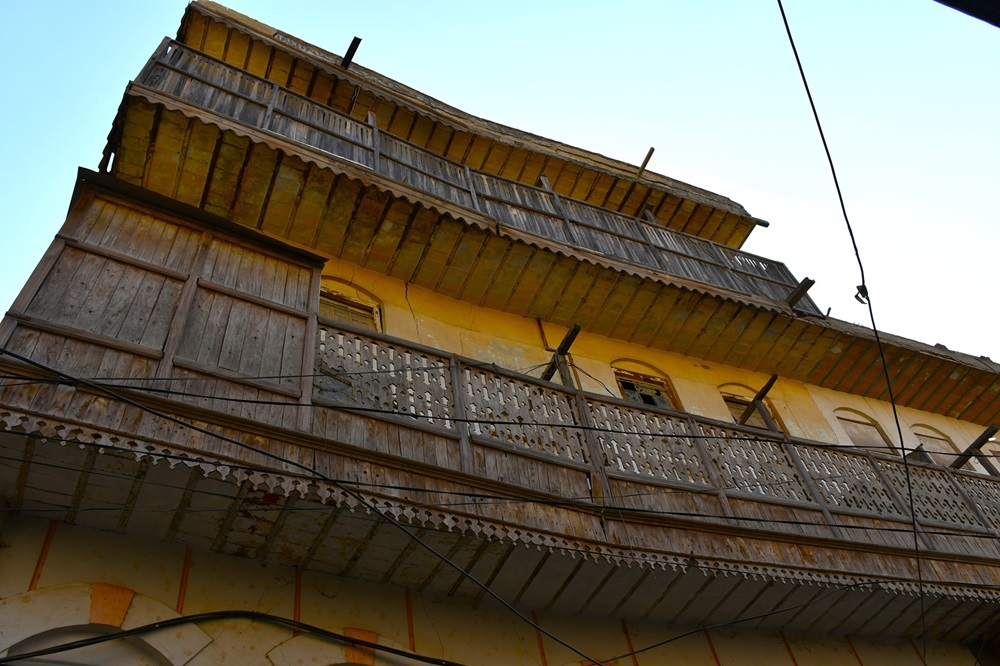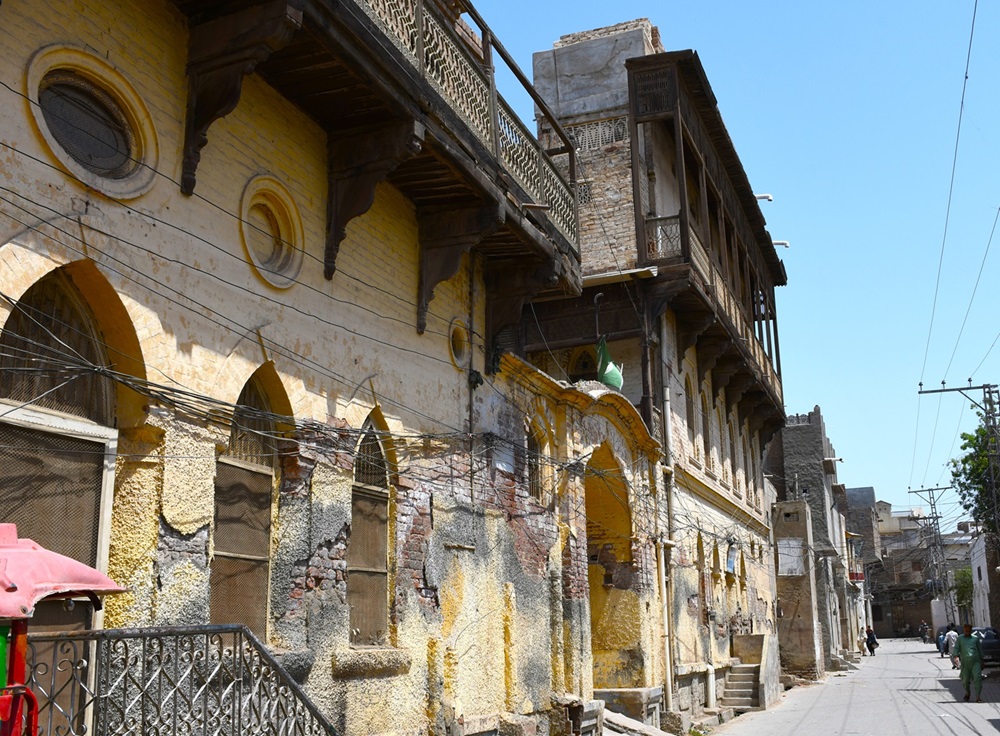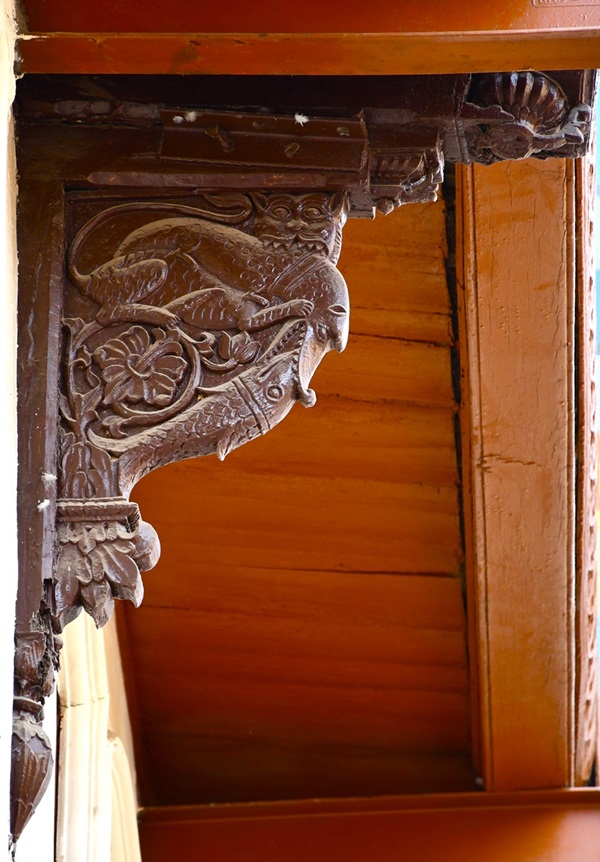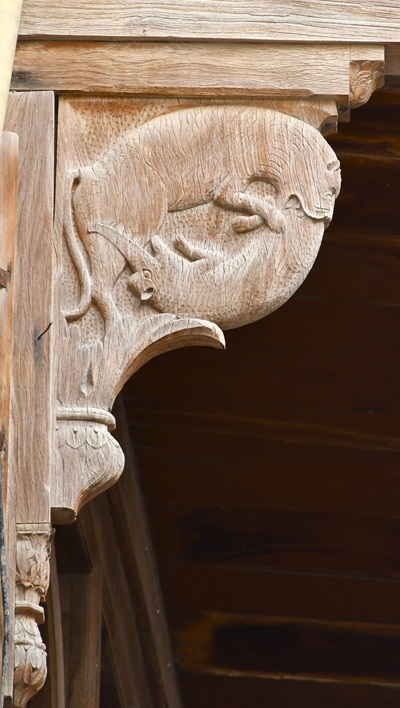Shikarpur city of Sindh is famous for its magnificent mansions, and the buildings from the pre-partition era
Shikarpur is famous for its magnificent mansions, and the buildings from the pre-partition era. Each is a unique masterpiece and reflects the opulence style of their builders. In every corner of the old locality of Shikarpur, there are splendid mansions, some of which have unfortunately lost their original beauty. However, the surviving havelis and maaris (mansions) stand tall, showcasing architectural elements that are not just beautiful, but also hold a significant place in Shikarpur’s history. They include intricately carved wooden facades, beautifully engraved balconies, stylishly ornamented windows, elaborately carved doors and decorative brackets.

Mansion with balconies in Karandar area (Picture credits to Zulfiqar Ali Kalhoro)
I have been documenting Shikarpur’s cultural heritage since 1998, and the city’s maaris (mansions) and havelis have always fascinated me. The ornamentation on both balconies and brackets is a testament to the artisans’ unparalleled craftsmanship and artistry. The intricate decorations on the architectural elements of havelis and maaris showcase the identity of the owners and artisans. The builders gave special attention to the brackets, doors and balconies in the mansions, while artisans dedicated considerable time to engraving and creating vivid and attractive designs. Each of the balconies in an old neighborhood of Shikarpur is a masterpiece, reflecting the artisans’ mastery over the art of woodcarving. Most old mansions are located inside the famous gates of Shikarpur, including Wagnodar, Hathidar, Hazaridar, Lakhidar, Karandar, Khanpuridar and Sividar. The havelis and maaris within these gates showcase remarkable balconies and brackets. The list of the havelis and maaris is very long, and I cannot discuss all of them. However, I will focus on a few havelis and maaris to give an insight into the beautiful woodcarvings found on the balconies and brackets.
Wooden balconies generally depict floral and geometric designs, whereas iron balconies show a variety of designs.
Some wooden balconies are found inside the Karandar area, while one haveli is located opposite the Plaza Cinema and is noted for its brackets and balcony. People from Shikarpur used wood in their buildings very often. Doors, windows, balconies, brackets, sunshades above windows, and columns were mainly made of wood and aesthetically carved.

Old mansion opposite to Plaza Cinema with brackets and balcony (Picture credits to Zulfiqar Ali Kalhoro)
Wooden balconies generally depict floral and geometric designs, whereas iron balconies show a variety of designs. In most cases, both iron and wood were used on the balconies of the mansions of Shikarpur. The balustrade is made of iron, while the columns holding it are wood. The upper part of the balcony is always made of fretted panels representing floral and geometrical designs. A few balconies, which have now been removed when the mansions were demolished, depict figures. One of the balconies which I saw in 2007 depicted three figures holding roses in their hands. This decorative panel of the balcony was one of the masterpieces from Shikarpur that was sold in the market when the mansion was demolished. Hundreds of such works of art from Shikarpur were sold in the market, depriving the city of its most valued creations of the local artisans.

Some balconies were made using wood and iron. Cast iron railings show figures such as Queen Victoria, dancing girls, the Hindu god Durga and many others. Some sacred Hindu symbols are also found on Shikarpur’s cast iron railings. It also shows a figure of Baba Guru Nanak, the founder of Sikhism. These depictions are now lost from the iron balustrade as most of the havelis have been demolished. However, one can see the figure of Baba Guru Nanak on the iron balconies in other cities of Sindh, and rather prominently in Hyderabad.
Iron balconies are found in the havelis located on Station Road, Awal Shah Padhar, Hathidar Road, Hazaridar, Kakra Lane (Kakran Jo Thalo), Shaikh Mohalla, Awan Mohalla and many other streets and localities of Shikarpur. In Lulla Mohalla’s Awal Shah Padhar is Seth Gulabrai’s mansion (now owned by the Khsos family), an imposing structure noted for its balconies. Hassaram Lala mansion, which was built in 1927 on Dadvai Road, is noted for its balconies. Both iron and wood were used on the balconies.
Wooden brackets in Shikarpur’s buildings depict animals, birds, fish, human figures, flowers and plants.
An extensive use of decorated and undecorated wooden brackets in façades and outer and inner balconies is a common feature of Shikarpuri havelis and maaris (mansions). Even a small structure features an ornate wooden façade with two to three carved brackets supporting the façades. Such carved brackets representing both secular and religious symbols are not found elsewhere in Sindh. However, many pre-partition buildings in Sindh’s major cities and towns, and in historical villages feature carved brackets. However, they are not as varied in terms of themes as those of Shikarpur.

Wooden brackets in Shikarpur’s buildings depict animals, birds, fish, human figures, flowers and plants. An old mansion in Awan Mohalla has impressive carved brackets, while nine ornately carved brackets support the long wooden balcony above. It is one of the most magnificent wooden brackets in Shikarpur. A few brackets are carved with very refined floral and figural patterns, which are not found in any other haveli in Shikarpur. The brackets display flowers along with birds and animals. One of the brackets features a depiction of a mythical animal with a creeper emerging from its mouth, ending in the form of a rosette. A bird is carved on the edge of the bracket. Another bracket shows flowers, a pair of parrots and Makara, an aquatic mythical creature, devouring another animal. Another bracket depicts a peacock from whose mouth emerges a creeper and spreads on the face of the bracket. Above the floral design is the mouth of Makara eating a fish.

Wooden bracket showing lion and Makara combat in Shikarpur (Picture credits to Zulfiqar Ali Kalhoro)
Makara is a recurrent theme for the artisans on the wooden brackets in Shikarpur. In some brackets, it is shown on its own, while in others it is shown in combat with a lion, symbolising some meaning for those who carved this design. This depiction is found on some brackets in an old building in Hussain Shah Mohalla. In one of the buildings near Hathidar, one finds a few carved brackets that support the wooden facade of the structure. On some, Makara is depicted eating fish. In Shikarpur’s Boot Bazar is also an old building noted for its highly carved facade. The three brackets support the wooden facade of the building. Two side brackets show Makara, while the central one displays the figures of Gandharvas (celestial beings). The most notable building representing Gandharvas and Gandharvis is located on the Hathidar Road. As per the English inscription on its main wooden door, this building was built by Lalchand Teckcand Matta in 1936. Like other Hindu families of Shikarpur, Mattas were also known for their business skills and philanthropic works in the city. Eleven decorated and undecorated brackets support the façade of the building that faces the Hathidar road. Three decorative brackets on the other side of the building represent Gandharvas and Gandharvis.
Apart from havelis and maaris, Gandharvas and Gandharvis’ wood carvings are also found on wooden brackets in a few temples and darbars of Shikarpur. Prominent among these darbars and temples is the Masand darbar, which has two brackets depicting Gandharvas on the main gateway.
In Shikarpur, wooden brackets often feature carvings of birds, particularly peacocks, pigeons and parrots, which seem to be the preferred theme of local woodcarvers. This trio of birds can also be found in wooden brackets in buildings across other cities and towns in Sindh.
______________________
Published under International Cooperation with "Sindh Courier"

Comments